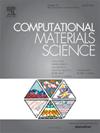Fully automated high-throughput computer-based catalytic material screening framework and its application on the new-generation Tianhe supercomputer
IF 3.1
3区 材料科学
Q2 MATERIALS SCIENCE, MULTIDISCIPLINARY
引用次数: 0
Abstract
The integration of high-performance computing with machine learning (ML) has established a transformative scientific paradigm that significantly enhances the efficiency of material discovery, particularly in the search for catalysts in alternative energy research. However, significant challenges remain in the utilization of available computational resources to accelerate the screening of catalyst materials. In this study, we implement a high-throughput framework on the new-generation Tianhe supercomputer, featuring the development of a Ping-Fault Recovery algorithm, single-task optimization for Density Functional Theory (DFT) to maximize efficiency, and enhanced task scheduling using a two-level scheduling strategy to ensure efficient utilization of the abundant computational resources of the supercomputer. This framework facilitates the identification of 2,028 candidate surfaces across 868 intermetallics from 2,713,897 unique adsorption sites, achieving a screening speed 193 times faster than traditional methods. Alloys composed of Mo, Nb, and V are used as case studies to provide a detailed elucidation of the process of identifying the most effective catalytic surfaces. The framework achieved the best single-day candidate hit performance on 18,106 nodes, completing in one day what previously took a year. This supercomputer-based framework optimizes the use of computational resources, driving innovation in catalyst material discovery.

求助全文
约1分钟内获得全文
求助全文
来源期刊

Computational Materials Science
工程技术-材料科学:综合
CiteScore
6.50
自引率
6.10%
发文量
665
审稿时长
26 days
期刊介绍:
The goal of Computational Materials Science is to report on results that provide new or unique insights into, or significantly expand our understanding of, the properties of materials or phenomena associated with their design, synthesis, processing, characterization, and utilization. To be relevant to the journal, the results should be applied or applicable to specific material systems that are discussed within the submission.
 求助内容:
求助内容: 应助结果提醒方式:
应助结果提醒方式:


